Stutthof concentration camp
Stutthof was a Nazi concentration camp established by Nazi Germany in a secluded, marshy, and wooded area near the small town of Sztutowo (German: Stutthof) 34 km (21 mi) east of the city of Danzig in the former territory of the Free City of Danzig. The camp was set up around existing structures after the invasion of Poland in World War II and initially used for the imprisonment of Polish leaders and intelligentsia.[1][2] The actual barracks were built the following year by prisoners.[3]
| Stutthof | |
|---|---|
| Nazi concentration camp | |
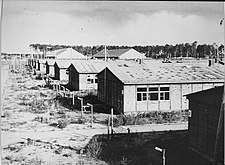 Prisoner barracks after liberation | |
| Operated by | Germany |
| Commandant | Max Pauly, September 1939 – August 1942 Paul-Werner Hoppe, August 1942 – January 1945 |
| Operational | 2 September 1939 – 9 May 1945 |
| Inmates | Jews, political prisoners |
| Number of inmates | 110,000 |
| Killed | 63,000 - 65,000 (including 28,000 Jews) |
| Liberated by | Red Army |

Stutthof was the first German concentration camp set up outside German borders in World War II, in operation from 2 September 1939. It was also the last camp liberated by the Allies on 9 May 1945.[4] It is estimated that between 63,000 and 65,000 prisoners of Stutthof concentration camp and its subcamps died as a result of murder, epidemics, extreme labour conditions, brutal and forced evacuations, and a lack of medical attention. Some 28,000 of those who died were Jews. In total, as many as 110,000 people were deported to the camp in the course of its existence. About 24,600 were transferred from Stutthof to other locations.[3]
Camp
The camp was established in connection with the ethnic cleansing project that included the liquidation of Polish elites (members of the intelligentsia, religious and political leaders) in the Danzig area and Western Prussia.[1]
Even before the war began, the German Selbstschutz in Pomerania created lists of people to be arrested,[3] and the Nazi authorities were secretly reviewing suitable places to set up concentration camps in their area.
Originally, Stutthof was a civilian internment camp under the Danzig police chief, before its subsequent massive expansion. In November 1941, it became a "labor education" camp (like Dachau), administered by the German Security Police. Finally, in January 1942, Stutthof became a regular concentration camp.[1]
The original camp (known as the old camp) was surrounded by the barbed-wire fence. It comprised eight barracks for the inmates and a "Kommandantur" for the SS guards, totaling 120,000 m². In 1943, the camp was enlarged and a new camp was constructed alongside the earlier one. It was also surrounded by electrified barbed-wire fence and contained thirty new barracks, raising the total area to 1.2 km² (0.5 sq mi). A crematorium and gas chamber were added in 1943, just in time to start mass executions when Stutthof was included in the "Final Solution" in June 1944. Mobile gas wagons were also used to complement the maximum capacity of the gas chamber (150 people per execution) when needed.
Staff

The camp staff consisted of German SS guards and after 1943, the Ukrainian auxiliaries brought in by SS-Gruppenführer Fritz Katzmann.[5]
In 1942 the first German female SS Aufseherinnen guards arrived at Stutthof along with female prisoners. A total of 295 women guards worked as staff in the Stutthof complex of camps.[6]
Among the notable female guard personnel were: Elisabeth Becker, Erna Beilhardt, Ella Bergmann, Ella Blank, Gerda Bork, Herta Bothe, Erna Boettcher, Hermine Boettcher-Brueckner, Steffi Brillowski, Charlotte Graf, Charlotte Gregor, Charlotte Klein, Gerda Steinhoff, Ewa Paradies, and Jenny-Wanda Barkmann. Thirty-four female guards including Becker, Bothe, Steinhoff, Paradies, and Barkmann were identified later as having committed crimes against humanity. The SS in Stutthof began conscripting women from Danzig and the surrounding cities in June 1944, to train as camp guards because of their severe shortage after the women's subcamp of Stutthof called Bromberg-Ost (Konzentrationslager Bromberg-Ost) was set up in the city of Bydgoszcz.[7]
Several Norwegian Waffen SS volunteers worked as guards or as instructors for prisoners from Nordic countries, according to senior researcher at the Norwegian Center for Studies of Holocaust and Religious Minorities, Terje Emberland.[8]
Prisoners
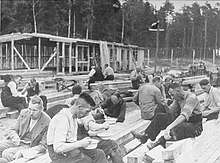
The first 150 inmates, imprisoned on 2 September 1939, were selected among Poles and Jews arrested in Danzig immediately after the outbreak of war.[3] The inmate population rose to 6,000 in the following two weeks, on 15 September 1939. Until 1942, nearly all of the prisoners were Polish. The number of inmates increased considerably in 1944, with Jews forming a significant proportion of the newcomers. The first contingent of 2,500 Jewish prisoners arrived from Auschwitz in July 1944. In total, 23,566 Jews (including 21,817 women) were transferred to Stutthof from Auschwitz, and 25,053 (including 16,123 women) from camps in the Baltic states.[1] When the Soviet army began its advance through German-occupied Estonia in July and August 1944, the camp staff of Klooga concentration camp evacuated the majority of the inmates by sea and sent them to Stutthof.
Stutthof's registered inmates included citizens of 28 countries, and besides Jews and Poles - Germans, Czechs, Dutch, Belgians, French, Norwegians, Finns, Danes, Lithuanians, Latvians, Belarusians, Russians and others. Among 110,000 prisoners were Jews from all of Europe, members of the Polish underground, Polish civilians deported from Warsaw during the Warsaw Uprising, Lithuanian and Latvian intelligentsia, Latvian resistance fighters, psychiatric patients, Soviet prisoners of war,[3] and communists (as an example of communist deportations to Stutthof, see the Danish Horserød camp). It is believed that inmates sent for immediate execution were not registered.
Conditions
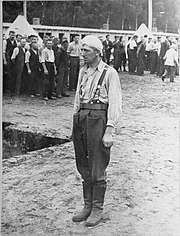
Conditions in the camp were extremely harsh.[9] The first executions were carried out on 11 January and 22 March 1940 - 89 Polish activists and government officials were shot.[3] Many prisoners died in typhus epidemics that swept the camp in the winter of 1942 and again in 1944. Those whom the SS guards judged too weak or sick to work were gassed in the camp's small gas chamber. Gassing with Zyklon B began in June 1944. 4,000 prisoners, including Jewish women and children, were killed in a gas chamber before the evacuation of the camp.[1] Another method of execution practiced in Stutthof was lethal injection of phenol into the heart. Between 63,000 and 65,000 people died in the camp.[3]
A range of German organisations and individuals used Stutthof prisoners as forced laborers. Many prisoners worked in SS-owned businesses such as DAW (Deutsche Ausrüstungswerke), the heavily guarded armaments factory meaning literally the German Equipment Works which was located inside the camp (see map) next to prisoner barracks. Other inmates labored in local brickyards, in private industrial enterprises, in agriculture, or in the camp's own workshops. In 1944, as forced labor by concentration camp prisoners became increasingly important in armaments production, a Focke-Wulf aircraft factory was constructed at Stutthof. Eventually, the Stutthof camp system became a network of forced-labor camps. The Holocaust Encyclopedia estimates that (less officially) some 105 Stutthof subcamps were established throughout northern and central Poland. The major subcamps were in Toruń (Thorn) and in Elbląg (Elbing).[5][10]
Sub-camps
The main German concentration camp in Stutthof had as many as 40 sub-camps during World War II. In total, the sub-camps held 110,000 prisoners from 25 countries according to the Jewish Virtual Library. The sub-camps of Stutthof included:[11][12]
- Bottschin in Bocień
- Bromberg-Ost in Bydgoszcz
- Chorabie (Chorab)
- Cieszyny
- Danzig–Burggraben in Kokoszki
- Danzig–Neufahrwasser
- Danziger Werft in Gdańsk
- Dzimianen (Dziemiany)
- Außenstelle Elbing in Elbląg
- Elbing / Org. Todt
- Elbing / Schichau-Werke
- Pölitz (Police near Szczecin)
- Gotenhafen in Gdynia
- Außenarbeitslager Gerdauen
- Graudenz in Grudziądz
- Grenzdorf (?)
- Grodno
- Gutowo
- Gwisdyn in Gwiździny
- KL Heiligenbeil (Mamonowo, Russia)
- Jesau/Juschny, Russia
- Kolkau
- Krzemieniewo
- Lauenburg
- Malken Mierzynek
- Camp Nawitz in Nawitz/Nawcz
- Niskie
- Obrzycko
- Praust/Pruszcz Gdański
- Brodnica
- Schirkenpass (Scherokopas)
- Schippenbeil/Sępopol, Poland
- Seerappen/Lyublino, Russia
- Sophienwalde
- Stolp/Słupsk
- Preußisch Stargard (Starogard Gdański)
- Bruss (Brusy)
- Thorn (AEG, Org. Todt) in Toruń
Commandants
- SS-Sturmbannführer Max Pauly, September 1939 – August 1942
- SS-Sturmbannführer Paul-Werner Hoppe, August 1942 – January 1945
Death march
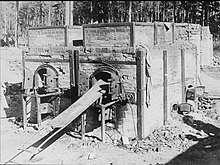
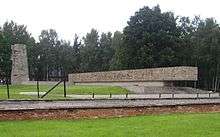
The evacuation of prisoners from the Stutthof camp system began on 25 January 1945. When the final evacuation began, there were nearly 50,000 prisoners, the majority of them Jews, in the Stutthof camp system. About 5,000 prisoners from Stutthof subcamps were marched to the Baltic Sea coast, forced into the water, and machine-gunned. The rest of the prisoners were marched in the direction of Lauenburg in eastern Germany. Cut off by advancing Soviet forces the Germans forced the surviving prisoners back to Stutthof. Marching in severe winter conditions and brutal treatment by SS guards led to thousands of deaths.
In late April 1945, the remaining prisoners were removed from Stutthof by sea, since the camp was completely encircled by Soviet forces. Again, hundreds of prisoners were forced into the sea and shot. Over 4,000 were sent by small boat to Germany, some to the Neuengamme concentration camp near Hamburg, and some to camps along the Baltic coast. Many drowned along the way.
On 5 May 1945, a barge full of starving prisoners was towed into harbour at Klintholm Havn in Denmark where 351 of the 370 on board were saved. Shortly before the German surrender, some prisoners were transferred to Malmö, Sweden, and released into the care of that neutral country. It has been estimated that around half of the evacuated prisoners, over 25,000, died during the evacuation from Stutthof and its subcamps.[13]
Soviet forces liberated Stutthof on 9 May 1945, rescuing about 100 prisoners who had managed to hide.[13]
Stutthof trials

.jpg)
The well known Nuremberg Trials were only concerned with concentration camps as evidence for war crimes and crimes against humanity committed by the Third Reich leadership. Several lesser known trials followed against the staff of various concentration camps. Poland held four trials in Gdańsk against former guards and kapos of Stutthof, charging them with crimes of war and crimes against humanity.
The first trial was held from April 25 to May 31, 1946 against 30 ex-officials and prisoner-guards of the camp. The Soviet/Polish Special Criminal Court found all of them guilty of the charges. Eleven defendants including the former commander, Johann Pauls, were sentenced to death. The rest were sentenced to various terms of imprisonment.
The second trial was held from October 8 to October 31, 1947, before a Polish Special Criminal Court. Arraigned 24 ex-officials and guards of the Stutthof concentration camp were judged and found guilty. Ten were sentenced to death.
The third trial was held from November 5 to November 10, 1947, before a Polish Special Criminal Court. Arraigned 20 ex-officials and guards were judged; 19 were found guilty, and one was acquitted.
The fourth and final trial was also held before a Polish Special Criminal Court, from November 19 to November 29, 1947. Twenty-seven ex-officials and guards were arraigned and judged; 26 were found guilty, and one was acquitted.
An additional trial was attempted in November 2018, when Johann Rehbogen was accused of being an accessory to murder. There was no evidence to link him to specific killings, and though he admitted to serving at the camp, he said that he was unaware that people were being murdered there.[14] He was charged as a juvenile, as he was under 21 at the time of the offense. Images in the news broadcasts concealed his face for legal reasons. Being tried at the age of 94, court proceedings were limited to no more than two hours per day and two non-consecutive days per week.[15] In February 2019 the trial of a defendant matching this description (whom Reuters reported could not be named for legal reasons) was halted after a medical report was issued stating that the defendant was unfit to stand trial, the trial already having been suspended since the previous December.[16][17]
Another Nazi camp guard, Bruno Dey, from Hamburg was charged in October 2019 of contributing to the killings of 5,230 prisoners at Stutthof camp between 1944 and 1945. He was tried in a juvenile court due to being about 17 at that time.[18]
The Game of Tag
In 1999, Artur Żmijewski filmed a group of nude people playing tag in one of the Stutthof gas chambers, sparking outrage.[19][20]
Notable inmates
- Ingrid Pitt, Polish-British actress, author, and writer
- Balys Sruoga, Lithuanian poet playwright, critic, and literary theorist
- Reidar Kvammen, Norwegian international football player
See also
- Female guards in Nazi concentration camps
- List of Nazi-German concentration camps
- Nazi crimes against ethnic Poles
- Rescue of Stutthof victims in Denmark
References
Citations
- Blatman, Daniel (2011). The Death Marches, The Final Phase of Nazi Genocide. Harvard University Press. pp. 111–112. ISBN 978-0674725980.
- Maria Przyłucka (1977). Praca więźniów w obozie koncentracyjnym Stutthof [Prisoner labour at Stutthof] (PDF). Zeszyty Muzeum Stutthof (2). Muzeum Stutthof w Sztutowie. p. 59 (4–5/19 in PDF). Retrieved 11 February 2015.
- Stutthof State Museum. "History of the concentration camp in Stuttfof" [Obóz koncentracyjny Stutthof (1939-1945)]. Sztutowo, Poland.
- "Stutthof, the first Nazi concentration camp outside Germany". JewishGen.org. Retrieved 21 January 2013.
- Holocaust Encyclopedia (20 June 2014). "Stutthof". United States Holocaust Memorial Museum. Retrieved 2 February 2015.
- Nunca Mas (2007), Datos de 295 Mujeres Pertenecientes a la SS: Christel Bankewitz, Stutthof, Historia Virtual del Holocausto, elholocausto.net; accessed 30 December 2017.
- Benjamin B. Ferencz. Less Than Slaves: Jewish Forced Labor and the Quest for Compensation. Retrieved 24 June 2013.
- "Norske vakter jobbet i Hitlers konsentrasjonsleire". Retrieved 21 January 2013.
- Matussek, Paul; et al. (1975). Internment in Concentration Camps and Its Consequences. Springer-Verlag. p. 19. ISBN 978-3-642-66077-1.
- Chris Webb, Carmelo Lisciotto (2007), Stutthof Concentration Camp. H.E.A.R.T at HolocaustResearchProject.org.
- "Forgotten Camps: Stutthof". JewishGen.org. Retrieved 24 June 2013.
- "Stutthof (Sztutowo): Full Listing of Camps, Poland" (Introduction). Jewish Virtual Library. Retrieved 7 October 2014.
Source: Atlas of the Holocaust by Martin Gilbert (1982)
- "Stutthof". U.S. Holocaust Memorial Museum. Retrieved 24 June 2013.
- Hope, Russell (6 November 2018). "Johann Rehbogen: Former SS guard, 94, on trial over deaths at Stutthof concentration camp". Sky News.
- "Nazi guard Johann Rehbogen denies role in concentration camp murders". Sky News. 13 November 2018.
- Ahlswede, Elke (2019-02-25). "German court stops trial of former death-camp guard".
- Associated Press (2019-02-25). "German court: Trial of Nazi guard unlikely to be restarted". Washington Post.
- "Former Nazi camp guard to go on trial in Hamburg". The Guardian. 17 October 2019.
- Harthorne, Michael (30 November 2017). "Outrage Over Naked Game of Tag Played in Nazi Gas Chamber".
- "Outrage Over Museum's Video-Art Display of a Nude Game of Tag in Gas Chamber". 8 July 2015.
Sources
- Stutthof National Museum. Selection of monographs in PDF from Zeszyty Muzeum Stutthof No. 1–8. Zakład Narodowy im. Ossolińskich. (in Polish)
- Memorial to the Victims of the Stutthof Concentration Camp
- Several authors, Monografia KL Stutthof (KL Stutthof monograph) Organization, prisoners, subcamps, extermination, responsibility. (in Polish)
- SS personnel serving at Ravensbrück, Axis History.com
- SS personnel serving at Stutthof, Axis History.com
- Balys Sruoga, Dievų miškas (The Forest of Gods). Novel by former Stutthoff prisoner, describing the everyday horrors of the camp. PDF file, direct download 1.6 MB (116 pages) from GoodReads.
- Holocaust Encyclopedia (2014), Stutthof United States Holocaust Memorial Museum, Washington, DC
- Brief facts and photos of the camp
- Joachim Neander *"The Danzig Soap Case: Facts and Legends around "Professor Spanner" and the Danzig Anatomic Institute 1944-1945", German Studies Review
External links
- Marek Orski: Zbrodnie hitlerowskie w obozie koncentracyjnym Stutthof : liczba ofiar w świetle źródeł i badań : próba bilansu. "Acta Cassubiana" 2000. Vol. 2.
| Wikimedia Commons has media related to |